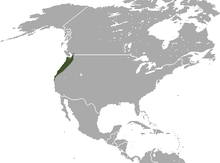| Marsh shrew | |
|---|---|

| |
| Scientific classification | |
| Domain: | Eukaryota |
| Kingdom: | Animalia |
| Phylum: | Chordata |
| Class: | Mammalia |
| Order: | Eulipotyphla |
| Family: | Soricidae |
| Genus: | Sorex |
| Species: | S. bendirii
|
| Binomial name | |
| Sorex bendirii Merriam, 1884
| |
| Subspecies | |
| |

| |
| Marsh shrew range | |
| Synonyms[2] | |
|
List
| |
The marsh shrew (Sorex bendirii), also known as the Pacific water shrew, Bendire's water shrew, Bendire's shrew and Jesus shrew is the largest North American member of the genus Sorex (long-tailed shrews). Primarily covered in dark-brown fur, it is found near aquatic habitats along the Pacific coast from southern British Columbia to northern California. With air trapped in its fur for buoyancy, marsh shrews can run for three to five seconds on top of the water. It measures about 16 cm (6.3 in) in length, including a 7-centimetre (2.8 in)-long tail, and weighs an average of 14.5–16 g (0.51–0.56 oz). The marsh shrew's diet consists mainly of invertebrates, which it hunts on land and in the water. They are rare; their populations are thought to be in decline, and they are considered endangered in parts of their range.
- ^ Cassola 2016.
- ^ Verts & Carraway 1998, p. 49.
